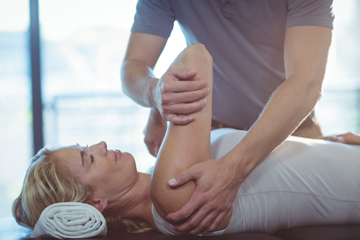
There are many factors and conditions that can lead to shoulder pain. Understanding the “Anatomy” of the Shoulder explained by “Washington University Orthopaedics” can help you figure out the factors that cause shoulder pain.
The shoulder is made up two joints: the acromioclavicular joint and the glenohumeral joint. The acromioclavicular joint where two bones meet – the shoulder blade (scapula) and the collar bone (clavicle). The glenohumeral joint is where the ball (humeral head) and the socket (the glenoid) meet.
The shoulder joint gets its range of motion from the rotator cuff, which is made up of a group of four muscles and their tendons that surround the shoulder joint, keeping the ball within the shallow socket of the shoulder. Tendons attach the muscles and bones. The muscles of the rotator cuff keep the ball tightly in the socket. The socket is shallow and flat. It is bounded with labrum, a soft tissue that makes a deeper socket to fit the ball. There is also capsular and ligament control in addition to muscle support around shoulder joint. The capsule that surrounds the shoulder joint is the fluid sac which is made up of ligaments and lubricates the joint. When stretched, the ligaments (soft tissues that hold bone to bone) help to tighten up the movements of the shoulder joint to restrict unwanted movement.
Shoulder pain can be caused by various conditions:
- Arthritis
- Torn cartilage
- Swollen bursa sacs or tendons
- Bone spurs
- Torn rotator cuff
- Frozen shoulder
- Dislocated shoulder
- Broken shoulder or arm bone
- Spinal cord injury
- Heart attack
The most common cause of shoulder pain is due to a condition known as impingement. The two main causes of impingement are:
- Posture related issues: You spend so much time hunched over your computer, other devices, at desks, even at the dinner table. As a result of the bad posture, your shoulders may feel tight and stiff. For instance, if you are standing, you let your shoulders round forward, your chest is tight and your head comes forward and then you try to rotate your hand over head there a mechanical block occurs and that will not let your hand to rotate further.
- Rotator cuff weakness: If it is not keeping the ball securely in the socket, this can result in pain, weakness, and reduced range of motion.
Here are some stretches to improve your posture and strengthening exercises to strengthen the rotator cuff muscles a keep the ball securely in the socket.
Stretches
- Rotation:
Sit or stand up straight.
Keep arms down at sides.
Rotate arms outward while trying to extend downward at the same time.
Hold for 5 secs and repeat. - Cross-arm stretch:
Bring your left arm across the front of your body at about chest height.
Use the other arm to support/hold your left arm.
Stretch out your shoulder and continue to face forward.
Hold for 30 secs.
Repeat on the other side. - Triceps stretch:
Bring your right arm up and over behind you.
Use the other arm to support the elbow.
Hold for 30 secs.
Repeat on the other side. - Ear to Shoulder
Sit straight and tilt your head toward your right shoulder.
Without lifting your left shoulder go far as you can.
Use your right hand to gently pull your head down to deepen the stretch.
Hold for 30 secs. - Head Tilt Clasp
Clasps your hands behind your back.
Slowly tilt your head side to side.
Hold each ear towards your shoulder while taking up to three big, deep breaths.
Repeat 10 times.
Strengthening Exercises for Rotator cuff muscles
These exercises can be done 2 or 3 times a week or directed by your physical therapist and should be performed slowly. If you feel worsening pain in your shoulder, shoulder blade or arm, stop the exercise. If you have rotator cuff injury, ask your physical therapist for assistance.
- Doorway stretch:
Stand in an open doorway and spread your arm out to the side.
Grip the sides of doorway with each hand at or below shoulder height.
Until you feel a stretch lean forward through the doorway.
When you lean keep straight back and shift weight onto your toes.
You should feel a stretch in the front of your shoulder.
Do not overstretch. - Isometric Internal rotation:
Put your elbow of your right hand by your side about 90-degree angle.
Push your right hand against the opposite hand.
Hold 10 secs.
Repeat 5 to 6 times. - Isometric external rotation:
Put your elbow of your right hand by your side about 90-degree angle.
Use the opposite hand to resist external rotation.
Push arm away from your body and hold 10 secs.
Repeat 5 to 6 times. - Internal rotation with weight:
Lie down on the side and put your elbow close to your side at a 90-degree angle.
Hold a weight (can be soup can or vegetable can), bring it up and then down.
Repeat 5 to 6 times. - External rotation with weight:
Lie on your side with your top arm bend to 90-degree angle.
Holding the weight and without moving your elbow rotate your hand outward taking the weight from your waist over to your top hip.
Repeat 5 to 6 times.
It is recommended that your consult your physician or a physiotherapist before doing shoulder exercises.